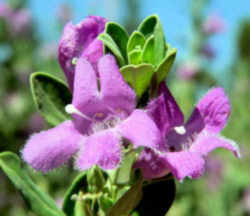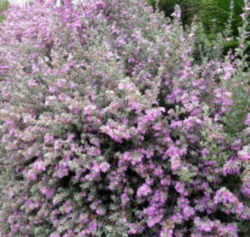
Texas Symbols
- State Resources
- » 50 States
- » Texas
- » Symbols
Texas State Native Shrub
Texas Purple Sage

(Leucophyllum frutescens)
Adopted on May 27, 2005
The Texas Purple Sage, (Leucophyllum frutescens) was adopted as the Texas State Native Shrub on May 27, 2005
A gray shrub with leaves covered with silvery hairs and bright pink-lavender, bilaterally symmetrical flowers borne singly in crowded leaf axils. Typically a compact shrub, 2-5 ft. tall, Texas barometer-bush or cenizo occasionally reaches 8 ft. in height, and 4-6 ft. width. Purple, violet, pink or white, bell-shaped flowers; small, silvery-white, oval, evergreen leaves; and a silvery, twisted trunk characterize this plant.
Texas State Native Shrub: Texas Purple Sage

Leucophyllum frutescens
is an evergreen shrub in the figwort family, Scrophulariaceae, native to the state of Texas in the southwestern United States and the states of Coahuila,
Nuevo León, and Tamaulipas in northern Mexico. Although commonly known as Texas Sage, it is not a true sage and is distinct from the genus Salvia.
The solitary axillary flowers are bell- or funnel-shaped, with five lobes and two lips. This species is found in rocky, calcareous soils
Common names
The species is also called Texas Ranger, Texas Rain Sage, Cenizo, Texas Silverleaf, Ash-bush, Wild Lilac, Purple Sage, Senisa, Cenicilla, Palo Cenizo, or Hierba del Cenizo.
Characteristics: Texas Sage, Texas Ranger, Texas Rain Sage, Cenizo, Texas Silverleaf, Ash-bush, Wild Lilac, Purple Sage, Senisa, Cenicilla, Palo Cenizo, Hierba del Cenizo
Cenizo is one our most outstanding native plants, a medium-sized shrub with a compact form, delicate silvery to gray-green leaves, and stunning displays of prolific purple blooms from summer into fall. It is sometimes called "barometer bush" because flowering is triggered by humidity or high soil moisture after rains. Cenizo's native range is from Northern Mexico through the Rio Grande Plains and Trans-Pecos, sparingly in the Western Edwards Plateau, into New Mexico. It grows on rocky caliche slopes and stony, calcareous soils. It is extremely drought and heat tolerant and maintenance-free once established. Cenizo is often used along highways and in commercial landscapes because of these qualities. However, to thrive in a landscape, it must have full sun and very well-drained alkaline soil. Although watering in dry summer months will make it grow faster, overwatering or poor drainage will quickly kill it, and shade will promote leggy growth and less flowering. In areas of high rainfall or poorly drained soil, cenizos should be planted in raised beds. If they are planted in acid soils, dolomitic limestone should be added. Fertilizing is unnecessary. Cenizos are not susceptible to pests or diseases other than cotton root rot, which well-drained soil will discourage. Sheared cenizo hedges are a common sight, especially in municipal plantings, but maintaining its natural shape with only light pruning produces a healthier and more aesthetically pleasing shape. This can be done in late winter or early spring before buds form, and possibly again in early summer. Cenizos are hardy to 5 degrees F. Leaves may become sparse in winter but will reappear with warmer weather. In 1982 Benny Simpson released two unusual selections: 'White Cloud', with white flowers, and 'Green Cloud', with green instead of silver leaves.
- Plant Habit or Use: medium shrub
- Exposure: sun
- Flower Color: purple, rarely white or pink
- Blooming Period: summer fall
- Fruit Characteristics: small capsule
- Height: to 8 feet
- Width: to 8 feet
- Plant Character: semievergreen
- Heat Tolerance: very high
- Soil Requirements: alkaline
House Concurrent Resolution 14
House Concurrent Resolution No.14, 75th Legislature, Regular Session (1997)
79R5137 MMS-D
By: Bonnen H.C.R. No. 71
CONCURRENT RESOLUTION
WHEREAS, The State of Texas has customarily recognized a
variety of official symbols as tangible representations of the
state's culture and natural history; and
WHEREAS, Like the bluebonnet and the pecan tree, Texas purple
sage (Leucophyllum frutescens) is indigenous to the Lone Star State and a treasured part of the Texas landscape; also known as cenizo, Texas silverleaf,
barometer bush, and Texas ranger, the plant grows naturally on the Edwards Plateau and the South Texas Plains; and
WHEREAS, This hardy evergreen was first described by Jean
Louis Berlandier, a botanist who collected specimens of Texas flora
in the late 1820s and early 1830s; bearing silvery gray to green
foliage, the shrub bursts into color year-round soon after a rain,
with blossoms varying from purple to lavender, pink, blue, and
white; and
WHEREAS, Native Americans brewed a pleasant herbal tea from
Texas purple sage and used it to treat chills and fever; the shrub
also provides forage for cattle, protection for birds, and a
nesting place for songbirds, including the state bird of Texas, the
mockingbird; in addition, the plant serves a multitude of design
functions, working well as an ornamental shrub or as a hedge,
screen, windbreak, or foundation planting; and
WHEREAS, Texas purple sage has been described as a plant that
"can face droughts, freezes, high winds, salt spray, hungry deer,
and blazing heat and keep right on performing beautifully," and
such fortitude is a quality highly admired in the Lone Star State;
and
WHEREAS, In view of this plant's important role in the
ecology of Texas and its usefulness to the people of this land from
ancient to modern times, it is altogether fitting that the Texas
purple sage be appropriately recognized; now, therefore, be it
RESOLVED, That the 79th Legislature of the State of Texas
hereby designate Texas purple sage (Leucophyllum frutescens) as the official State Native Shrub of Texas.
Taxonomic Hierarchy: Texas Purple Sage
Kingdom: Plantae - Plants
Subkingdom: Tracheobionta - Vascular plants
Superdivision: Spermatophyta - Seed plants
Division: Magnoliophyta - Flowering plants
Class: Magnoliopsida - Dicotyledons
Subclass: Asteridae -
Order: Scrophulariales -
Family: Scrophulariaceae - Figwort family
Genus: Leucophyllum Bonpl. - barometerbush
Species: Leucophyllum frutescens (Berl.) I.M. Johnston - Texas barometer bush







